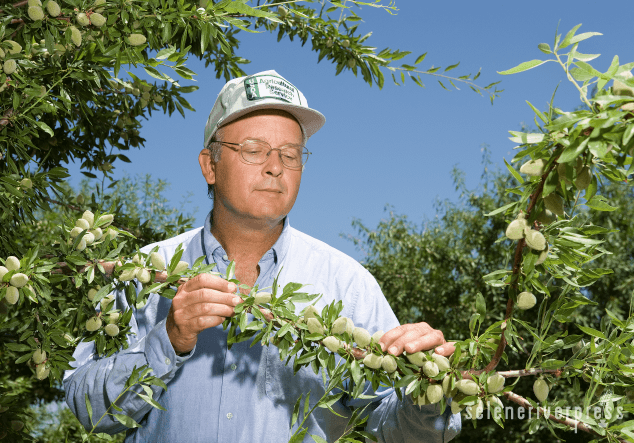Geneticist Craig Ledbetter examines a self-pollinating almond selection in a California test plot.
Here’s one thing I thought I knew absolutely: almonds require honeybees for pollination. Well, it turns out I was almost correct.
Eighty percent of the world’s almond crop is grown in California on more than 600,000 acres. That’s where the best attributes—long, dry summers and adequate chill hours— magically come together, mostly in the San Joaquin Valley, but now increasingly in Madera and Fresno counties. Almonds are California’s top food export and the nation’s sixth largest export, finding their way to 90 countries worldwide.
Most almond tree cultivars require a second tree of a different variety for proper pollination and the help of a honeybee to carry the pollen from one tree to another. That is to say, if you have a standard almond tree, you need to have a second, different cultivar for pollination. These are known as “self-unfruitful varieties,” and they include Ne Plus Ultra, Nonpareil, Carmel, Mission, and Price. Two self-unfruitful varieties such as Nonpareil will not pollinate each other.
With the help of the USDA Agricultural Research Service (ARS), all that is about to change.
Research has been in progress for two decades to produce hybrid almond trees that are self-pollinating. Starting with an Italian self-pollinating almond, researchers produced new varieties showing similar attractive fruit attributes to the traditional cultivars. The original plantings occurred in orchards in 1996, and the 2006 crop produced excellent results.
Almond trees reach full bearing potential in 5 to 6 years. Blossom is in February. The fruit matures in autumn, 7 to 8 months after flowering. They’re sensitive to a huge array of factors, all of which are carefully monitored by highly educated farmers. These factors include traits like nut size, flavor, disease sensitivity, bloom coincidences, chilling hours, color, uniform kernel quality, blanchability, and oil content, plus traits for slicing, slivering, and roasting. They also include geographic factors like various latitudes, elevations, soils, rainfall and humidity.
One new self-pollinating variety, called Independence, set commercial crops in replicated trials using tented bee-free environments. Independence was made commercially available in 2009, and as of July 2011 it was expected to have a noticeable market impact within a couple of years. Farmers expected to know if the trees would stand up in the commercial market by about 2018.
But here we are in 2014 and guess what’s easily found for sale? The internet is sprinkled with ads like this:
“Exclusive to Plantnet…New—Dwarf Self-Pollinating Almond…All varieties grow to a height of 1.5m-2.0m and a width of 1.5m-2.0m.”
“Almond Self-Pollinating, Retail $26.95. Prunus dulcis…one of the most beautiful winter flowering trees…just 50g of nuts can supply 10% of your daily calcium needs.”
It turns out that even a self-fertile almond tree benefits from honeybee visits. Bees increase pollination and nut set percentage. The data simply does not support bee-less practices. Still, the need for bees will be significantly reduced—think by half—leaving the beekeeper with yet another looming loss of income. The 1980s delivered tracheal mites. The 1990s brought varroa mites. With the 2000s came so-called Colony Collapse Disorder (it’s the poisons—not a mystery). And now it seems with the 2010s comes the next nail in the coffin: self-fertilized trees.
As of February 2012, orders for Independence (Zaiger Genetics) almond trees exceeded orders for the dominant and widely known Nonpareil variety. Almond farmers can save as much as $250 to $300 per acre by reducing the cost of bees. Pollination accounts for about 16 percent of the per-acre cultural cost of growing almonds. Some growers have opted to have no hives at all, counting on the self-pollination and naturally occurring pollinators to get the job done.
What industry could hold up against such an ongoing series of devastating events? No wonder beekeepers are going out of business. I’m beginning to wonder if keeping bees is analogous to making horse buggies. Very quaint and perhaps of interest to tourists, but in no way qualifying as a means to support a family.
The USDA/ARS began the new tree effort a full decade before CCD appeared. This was just normal incremental improvement in the tree industry for them. There was no sinister attack on beekeeping. But the timing of their success may well turn out to be quite calamitous.
Beekeepers have a talent, one they developed in order to feed their families. Just as farmers use their well-developed talents to feed their families. How sad it is to see this comment on one of the new tree articles from an almond farmer who goes by Grouleff3: “Colony collapse, nonsense just a bunch of greedy bee keepers mismanaging their colonies.”
Really? The fact is that management techniques in no way correlate to colony loss (see six years of survey data at Bee Informed). And why would beekeepers intentionally mismanage the creatures on which they depend?
Okay, great—let’s say the almond trees don’t need the honeybees after all, and the almond farmers save millions. Should we take this as justification to stay on our current course of exterminating all insects because they’re inconvenient to humans? The answer is no! Even if the honeybee shortage is eliminated because fewer crops need to be pollinated, we still need to put an end to the massive, unnecessary, poisoning of Earth.
Commercial beekeepers are on a very difficult trajectory. Most will readily tell you that the almonds make their business work, which is just what commercial beekeeper Dave Hackenberg confirmed to me in personal correspondence. If we’re to have honeybees in our future, if we’re going to have raw local honey in our future, it may well fall to the hobbyist. They need your encouragement.
(Photo credit: USDA/ARS, Public Domain)
 Get self-health education, nutrition resources, and a FREE copy of A Terrible Ten: Health Foods That Ain't ebook.
Get self-health education, nutrition resources, and a FREE copy of A Terrible Ten: Health Foods That Ain't ebook.
